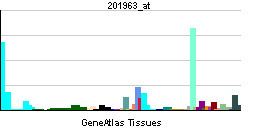Entrez 2180 | Ensembl ENSG00000151726 | |
 | ||
Aliases ACSL1, ACS1, FACL1, FACL2, LACS, LACS1, LACS2, acyl-CoA synthetase long-chain family member 1 External IDs MGI: 102797 HomoloGene: 37561 GeneCards: ACSL1 | ||
Long-chain-fatty-acid—CoA ligase 1 is an enzyme that in humans is encoded by the ACSL1 gene.
Contents
Gene
The ACSL4 gene is located on the 4th chromosome, with its specific location being 4q35.1. The gene contains 28 exons.
The protein encoded by this gene is an isozyme of the long-chain fatty-acid-coenzyme A ligase family. Although differing in substrate specificity, subcellular localization, and tissue distribution, all isozymes of this family convert free long-chain fatty acids into fatty acyl-CoA esters, and thereby play a key role in lipid biosynthesis and fatty acid degradation.
In melanocytic cells ACSL1 gene expression may be regulated by MITF.
Function
The protein encoded by this gene is an isozyme of the long-chain fatty-acid-coenzyme A ligase family. Although differing in substrate specificity, subcellular localization, and tissue distribution, all isozymes of this family convert free long-chain fatty acids into fatty acyl-CoA esters, and thereby play a key role in lipid biosynthesis and fatty acid degradation. Several transcript variants encoding different isoforms have been found for this gene. This specific protein is most commonly found in mitochondria and peroxisomes.
Clinical significance
ACSL1 was shown to be involved in nonspecific mental retardation and fatty-acid metabolism. Since the ACSL4 gene is highly expressed in brain, where it encodes a brain specific isoform, an ASCL1 mutation may be an efficient diagnostic tool in mentally retarded males.
Interactions
ACSL1 expression is regulated by SHP2 activity. Additionally, ACSL4 interacts with ACSL3, APP, DSE, ELAVL1, HECW2, MINOS1, PARK2, SPG20, SUMO2, TP53, TUBGCP3, UBC, UBD, and YWHAQ.
